 Aprilfestival: Teater for Små & Store is an annual performance event for young audiences, each year taking place in a different Danish town. This April, over 100 Danish and international companies performed over 600 shows in diverse spaces – from classrooms to viking halls to basketball courts – transforming the 2015 host town of Frederikssund (50km outside of Copenhagen). Traveling to the festival with the support of the Arts Council’s Travel and Training Award (with the Elk project and questions of accessibility on my mind), I was thinking about the festival’s amazingly enabling ethos and core aim – to give every single child in a regional municipality a theatre experience. And I was curious to see how the performance work would fit into non-theatre contexts, how it was changed by the fit-up nature of the festival, by the rough-and-ready settings – and how those spaces were in turn transformed.
Aprilfestival: Teater for Små & Store is an annual performance event for young audiences, each year taking place in a different Danish town. This April, over 100 Danish and international companies performed over 600 shows in diverse spaces – from classrooms to viking halls to basketball courts – transforming the 2015 host town of Frederikssund (50km outside of Copenhagen). Traveling to the festival with the support of the Arts Council’s Travel and Training Award (with the Elk project and questions of accessibility on my mind), I was thinking about the festival’s amazingly enabling ethos and core aim – to give every single child in a regional municipality a theatre experience. And I was curious to see how the performance work would fit into non-theatre contexts, how it was changed by the fit-up nature of the festival, by the rough-and-ready settings – and how those spaces were in turn transformed.
I visited some brilliant schools. The performances were woven into the fabric of the day, children moving from maths class to a show to language lab to lunch. Even in the smallest schools, performances might have been taking place at the same time in several classrooms, the gym, the library, the yard. In little rooms, tables and chairs were rearranged into improvised raked seating, windows blacked out with refuse sacks and parcel tape.
For me at least, the less dynamic work was that which attempted to impose a theatrical space where none existed, an obsession with drapes and rigging and blackouts and theatreness, to recreate a black box or proscenium arch, to try too hard to hide the fact that we were in a classroom or a gymnasium. And on the other end of the spectrum, the vibrant work for me was so often that which did the opposite – embracing the non-theatrical nature of the spaces in order to elevate the space and the work itself, an attention to detail and artistry that suspended them without hiding or apologising for them – transforming and reawakening them into an other world.
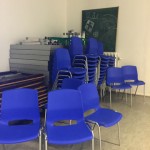
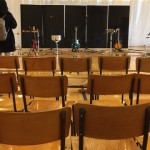
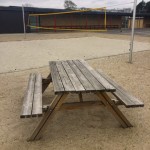

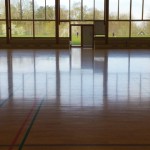
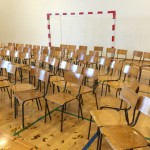


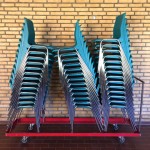
A plastic bucket school chair takes on a life of its own. The coloured stripes of a multi-use sportshall floor become a key aspect of Lisa Becker and Claus Carlsen’s Besat af æbler for Teatrer Nordkraft (an early years live-art work and my hands-down highlight of the festival). A glossy classroom whiteboard acts as the perfectly reflective projection backdrop for the Northern Lights above the Tundra in World Images by Teater Madam Bach (directed by Imaginary Theatre Australia’s Thom Browning).
So many brilliantly found spaces transformed, so many times I thought, “I really want to make a show here.”
OTHER THOUGHTS
Elk was in my mind. I was thinking about the pathos of a creature doomed to extinction, about how to have an open and frank conversation about the vast world we live in with young audiences while at the same time offering a steady and sympathetic guide to navigating that bigness. And so it was brilliant to be immersed in Danish work, a tradition that does not shy away from the oftentimes dark reality of the world we live in. I encountered performances that dealt in many different ways with death, change and loss.
Teatret Gruppe 38’s Morket Ligger Under Sengen / The Darkness Rests Under the Bed was another highlight of the festival. A story about an older couple who return home to stay with their son, it drew gentle and playful parallels between a toddler’s fear of what lurks beneath their bed, and an elderly person’s fear of what might come in the night. The simplicity of its storytelling, its matter-of-factness, its placement of youth, age, life, death, light and dark on one plane and in one breath will stay with me.
BESAT AF ÆBLER BY LISA BECKER, CLAUS CARLSEN + TEATER NORDKRAFT
MØRKET LIGGER UNDER SENGEN BY TEATRET GRUPPE 38














